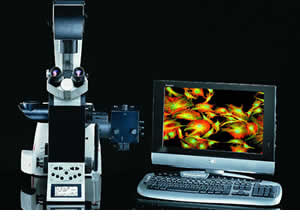Leica DMI4000 B Inverted Microscope
Leica Updated: 2009-02-09 RSS
inverted Leica DMI4000 B was designed for applications in life science. Outperforming not only the latest technical standards but also all the ergonomic demands of a modern microscope, the automated research microscope is also suitable for scanning cell and tissue cultures.
With its completely new fluorescence axis it guarantees ultra-brilliant fluorescence. The internal filter wheel with motorized ExMan and FIM enables excitation of fluorochromes in less than 20 milliseconds. The Leica DMI4000 B can be combined with any of the solutions from Leica's product range.
Key Features
* Ergonomic designed tubes with an integrated "View-Chute" to get a glance to the sample on the stage with naked eyes
* Ergonomic designed stand in cooperation with the Fraunhofer Institute (IAO)
* Tremendous free working range with the new S28 condenser and ultra small stages
* Status display, all microscope settings at a glance
* Constant Color Intensity Control (CCIC) keeps the color temperature in TL axis constant at 3,200k
* Integrated Interpupilary Interface for a direct access to the back focal plane to adapt different contrasting techniques
* Fluorescence Intensity Manager (FIM) to attenuate the fluorescence intensity
* New fluorescence filter cubes with reduced background intensity. No additional BG38 needed.
* Ultra fast internal filter wheel (IFW) for high-speed fluorescence application allows to change excitation wavelengths within the range of milliseconds
* Zero Pixel shift fluorescence facilitates overlay of images
* Motorized Excitation Manager for levelling different fluorescence intensities in 17 reproducible steps
* Choice between round or rectangular field diaphragms to fit the eyepieces or chip size of the camera
* Combination Contrast allows the combination of one TL contrast technique with fluorescence (PH/FLUO or DIC/FLUO)
Let there be light
Change the objective, adjust the brightness and diaphragms. How many times a day do you do that? As of now, it's history! The illumination manager of the Leica DMI microscopes will handle it for you reliably.
When changing magnification or contrast technique, it automatically sets the brightness, aperture and field diaphragm to their optimal values. And if you have special requirements regarding the settings? Then simply adjust them and the microscope will adopt them immediately.
Less for more
What's more, the light intensity control can also be used for fluorescence. The Leica FIM (Fluorescence Intensity Manager) regulates light intensity at five fixed levels – and remembers the setting for each filter cube.
Contrast – as if by magic
The days of tinkering around with condensers are over and you're not going to miss them. With the Leica DMI series, simply press the "PH" button and phase contrast is set automatically.
The microscope knows the correct phase ring for each objective and positions it in the beam path. Differential interference contrast is even more astonishing: at the touch of a button and the analyzer, polarizer, and the correct prism pair for the objective automatically swing into the beam path.
Changing contrast techniques can be that simple: whether transmitted light or fluorescence – all it takes is a touch of a button.
Take the optics in your own hands – the new intermediate modulation contrast (IMC)
Our optics experts have outdone themselves – and created an intermediate interpupillary interface. What is it good for? Simple: modulation contrast in complete perfection, with bright-field objectives. An optical stroke of genius that's easy on your budget.
Why settle for less? – The new intermediate phase contrast (IPH)
If you can realize modulation contrast with bright-field objectives, why buy special objectives for phase contrast? We asked ourselves that as well and applied the intermediate pupil interface to another revolutionary phase contrast method, IPH. The first phase contrast in which you can influence the contrast yourself – also with bright-field objectives.
Colorful as the rainbow
Multiple excitations are used in modern fluorescence microscopy to make a variety of cell compartments visible simultaneously. It's equally important to be able to observe the various stains individually. Until now, conventional instruments required multiple fluorescence filters to realize this.
With the Leica DMI microscopes, this is now possible with a single filter cube: multiple-fluorescence filter cubes, together with the ultrafast IFW internal filter wheel permit the separation of nearly all GFP variants as well as traditional fluorescence stains and equally fast change-over on the emission side – all within 0.05 seconds.
Black as night
A fast shutter is essential for most fluorescent observations. Leica DMI microscopes even have two integrated shutters. The shutter which can be reached most quickly is used automatically. The excitation can thus be interrupted in less than 0.1 seconds for optimal protection of the specimen.
Brochures
Flyer
Related Manuals
Leica DMI3000 B Inverted Microscope
Leica DMI6000 B Inverted Microscope
Leica DMD108 Digital Microimaging Device
Leica DM2500 MH Materials Microscope
Leica DM4000 M Research Microscope
Leica DM6000 M Research Microscope
Leica DMI3000 M Inverted Microscope
Leica DMI5000 M Inverted Microscope
Leica DM ILM Inverted Microscope
Leica DM4500 P Polarization Research Microscope
Leica LMD7000 Laser Microdissection System
Leica AM6000 Micromanipulation System